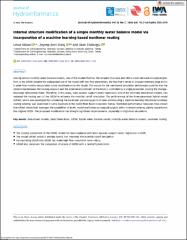Internal structure modification of a simple monthly water balance model via incorporation of a machine learning-based nonlinear routing

Göster/
Erişim
info:eu-repo/semantics/openAccesshttp://creativecommons.org/licenses/by-nc-nd/3.0/us/Tarih
2024Üst veri
Tüm öğe kaydını gösterÖzet
Among various monthly water balance models, one of the models that has the simplest structure and offers a well-behaved conceptual platform is the GR2M. Despite the widespread use of the model with two-free parameters, the fact that it tends to produce relatively large errors in peak flow months necessitates some modifications to the model. The reason for the mentioned simulation deficiencies could be that the relationship between the routing reservoir and the external environment of the basin is controlled by a single parameter, making the storage–discharge relationship linear. Therefore, in this study, least squares support vector regression, one of the nonlinear data-driven models, has replaced the routing part of the GR2M to enhance the monthly runoff simulation. The performance of the three-parameter hybrid model (GR3M), which was developed by considering the parameter parsimony point of view and including a machine learning (ML)-based nonlinear routing scheme, was examined in some locations in the Gediz River Basin in western Turkey. Statistical performance measures have shown that GR3M, which both leverages the capabilities of an ML model and blends conceptual outputs within a nested scheme, clearly outperforms the original GR2M. The proposed modification has brought significant improvements, especially to high-flow simulations.
Kaynak
Journal of HydroinformaticsCilt
26Sayı
7Koleksiyonlar
Aşağıdaki lisans dosyası bu öğe ile ilişkilidir:


















